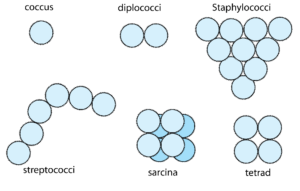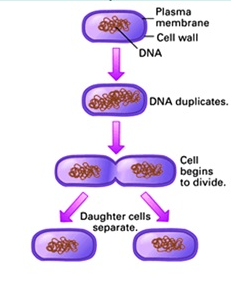The living organisms which cannot be seen with the naked eyes (unaided eyes) and can only be observed through a microscope are called microorganisms or microbes. The branch of science that deals with the study of microorganisms is known as microbiology. Microorganisms may be single-celled like bacteria, some algae, and protozoa, or multicellular, such as algae and fungi.
Microorganisms occur everywhere. They are found in air, water (ponds, lakes, rivers, and oceans), soil, marshlands, inside our bodies. They are present in adverse environments like polar regions, hot deserts, in cracks in the seafloor, volcanic eruption, hot spring deserts, snow, and deep oceans. They remain inactive under such adverse conditions and become active whether favourable conditions are available again. In adverse conditions like temperature and dryness microorganisms, form a hard outer covering called a cyst around themselves. They survive by remaining inactive within the cyst until conditions are favourable again.
Classification of Microorganisms:
Microorganisms are classified into five major groups as follows: Bacteria (singular: bacterium), Fungi (singular: fungus), Protozoa (singular: protozoan), Algae (singular: alga), Viruses (singular: viruses).
Viruses are microscopic. They reproduce only inside the cells of the host organism, which may be a bacterium, plant or animal.
Bacteria
The kingdom Monera is also referred as kingdom prokaryotae. Organisms of kingdom Monera are called lower level organisms because no tissue level organization is present in them. Their one cell is capable of performing all the functions of cell. This kingdom includes bacteria, cyanobacteria, archaebacteria, mycoplasma, rickettsia, actinomycetes.
In 1683 a Dutch merchant and lens maker Anton van Leeuwenhoek observed bacteria for the first time and called them animalcules. Ehrenberg coined the term bacteria in 1929. In 1881 Robert Koch observed that bacteria causes diseases like cholera, tuberculosis in human being and anthrax in cattle. The branch of science that deals with the study of bacteria is called Bacteriology.
Characteristics of Bacteria:
- They are unicellular prokaryotic organisms.
- They are present in air, water, soil, snow etc. They are present at very cold (minus degree) temperature regions and also very high temperature regions. They can live in acidic environment (helico bacter pyroli) and even basic environment (iron bacteria). Some of the bacteria are highly resistant to adverse environments. Even they get tolerance to harsh chemical and other stuff which destroy them.
- They have a cell wall which is distinct from other cells having cell wall. The wall is made of peptidoglycan also called murein or mucopeptide.
- In plant or animal cell, cell membrane is present immediately below the cell wall. In bacteria especially the gram negative ones have an extra membrane i.e. an outer membrane called periplasm which lies below cell wall but above cell membrane.
- Food reserve is in the form of glycogen and fat globules.
- They don’t have an organised nucleus. Bacterial DNA is contained in one circular chromosome, inside the cytoplasm> It is called nucleoid.
- The protein making machinery in them has 70S ribosome which is of two sub-units as 50S and 30S. While in other animals and plants, it is 80S ribosome consisting of two sub-units 60S and 40S.
- They lack membrane-bound organelles like mitochondria, chloroplast, endoplasmic reticulum and golgi complex.
- They shows different modes of nutrition including photoautotrophic, chempautotrophic, saprotaophic, parasytic and symbiotic.
- When the environmental conditions around are harsh, the bacteria converts to a hard spore form. This spore is highly resistant to heat, chemicals and drought conditions.
- Reproduction is mainly by fission. But gene recombination can takes place by conjugation.
Size of Bacteria:
They are much smaller than eukaryotic cell. The average diameter of spherical bacterial cell is 0.5-2.0 µm. For rod-shaped or filamentous bacterial cell, length is 1-10 µm and diameter is 0.25-1 .0 µm.
Types of Bacteria on the Basis of Shape:
Cocci:
They are round cells, sometimes slightly flattened when they are adjacent to one another. If they occur singly they are called micrococus, if occur in a pair is called diplococcus, if occur in a group of 4 is called tetracoccus, if occur in chain are called streptococcus and if occur in a grape like bunch structure are called staphylococcus.

Bacilli:
They are rod-shaped bacteria with or without flagella. If they occur singly they are called microbacillus, if occur in a pair is called diplobacillus, if occur in the chain are called streptobacillus.
Spirilla:
They are coiled bacteria which can range from a gently curved shape to a corkscrew-like spiral. Many spirilla are rigid and capable of movement. A special group of spirilla known as spirochetes are long, slender, and flexible. e.g. spirilum, spirochaete
Vibrio:
They are motile, comma shaped with a flagellum. e.g. vibrio
Types of Bacteria on the Basis of Number of Flagella:
- Atrichous: No flagella. e.g. Lactobacillus
- Monotrichous: Single flagellum. e.g. Vibrio cholarae
- Amphitrichous: Two flagella. one each at either end. e.g. Nitrosomonas
- Cephalotrichous: Many flaglla at one end. e.g. Pseudomonas fluorescens
- Lophotrichous: Many flagell at both ends. e.g. Spirillum volutans
- Peritrichous: Many flagella all over the body. e.g. Salmonella typhi, E.coli.
Cell Structure:
The organism may be unicellular as in eubacteria and filamentous as in cyanobacteria. A cell of a bacterium has the cell wall made up of peptidoglycan and not of cellulose as in case of plants. It encloses cell membrane and cytoplasm. Cell membrane and cytoplasm is collectively called as a protoplast. Cell membrane encloses cytoplasm.
A well-developed nucleus is not found, but the nuclear material i.e., chromosomes, is found scattered in the cytoplasm. Besides nuclear material cytoplasm consists of vacuoles, granules and in very few cases green pigments.
Sometimes the cell is enclosed within a gelatin-like envelope called capsule. They may have flagella which are a thread like structure that help in movement.
Movement:
Most bacteria cannot move about on their efforts. They have to depend on wind, water or contact for their movement. Some of them can move in a liquid medium very easily with the help of whip-like structures called flagella.
Nutrition:
Most bacteria lack chlorophyll hence they depend on other organisms for food (heterotrophic).Therefore, they either live as saprophytes (get nutrition from dead and decaying organisms) or parasites (get nourishment from the body of the living host).
Some bacteria live in symbolic relationship with the other organisms. For example, a bacterium called Escherichia coli lives in the intestine of man.
Some bacteria in spite of the absence of chlorophyll make their own food, with the help of chemicals like sulphur, hydrogen sulphide etc. The food production process is named as chemosynthesis.
Bacteria secrete powerful enzymes from their cells into surrounding material making it soluble and then can readily be absorbed.
Respiration:
Some bacteria are aerobic (require oxygen for respiration), while some are anaerobic (do not require oxygen for respiration). Anaerobic bacteria get killed when exposed to oxygen.
Reproduction:
Asexual Reproduction:
Under favourable conditions i.e., suitable temperature, moisture, and enough food, bacteria divide rapidly. They multiply by fission. A bacterium simply divides into two organisms. Bacteria may divide as often as once in every 20 to 40 minutes.
Fission can be of two types binary and multiple. In multiple fission, many daughter cells are formed. In binary fission bacterial the DNA duplicates and the cell grows. The two DNAs are pulled apart. The cell constricts in the middle separating the two cells. Depending upon the type of bacteria, the two daughter cells may remain attached or may separate from each other as independent cells.

Bacteria divide at very fast rate, once in every half an hour. Let us consider a single bacteria undergoing division. At the end of 24 hours there will be 224 bacteria = 281,514,871,750,656 bacteria.
Spore Formation:
Spore formation is not a method of reproduction but to survive in adverse conditions. Whenever unfavourable conditions like drying up of vegetation prevail, the bacterial cell draws its content in a spherical mass which is protected by a thick, hard protective wall. This spherical body is called spore. these spores are contained in the cell wall. The spores can be carried out by wind or water or contact.
On obtaining favourable conditions, the spores germinate. Their protoplasm becomes active and comes out of the ruptured wall to form a new bacterium.

Sexual Reproduction:
Very few bacteria show sexual reproduction and it is extremely simple. In this method, two bacteria of different strains but of the same species come together for conjugation. The plasmid the donor is transferred into the recipient through a hollow tubelike extension of the donor cell.
